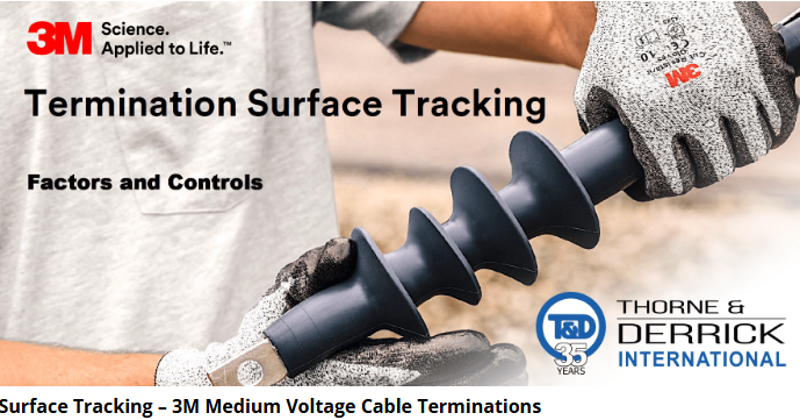3M Terminations | Surface Tracking on Medium Voltage Cable Terminations
Posted on 15 November 2024

Surface Tracking on Cable Terminations
Surface tracking is the irreversible damage and degradation on the surface of a medium or high voltage cable accessory or insulative material, such as a cable termination, due to the formation of conductive, carbonized paths.
Tracking results when discharges cause carbon to be left on an insulating surface as a result of the degradation caused by the heat of the discharge. This carbon deposit will grow to eventually create a continuous conducting path, which will lead to catastrophic failure.
Cold Shrink & Condensation In Medium Voltage Switchgear & Cable Terminations
Hydrophobic silicone Cold Shrink terminations provide excellent performance in electrical equipment, such as switchgear, where cables endure temperature fluctuations caused by thermal cycling when under load – this “heating and cooling” effect condensates potentially causing premature partial discharge at the cable termination point.
N2XS(F)2Y Cable Terminations 12/20 22kV 24kV
Energising Data Centres | The QTIII range of MV Terminations are approved and in widespread service throughout the data centre sector for 12/20 (24)kV connection of N2XS(F)2Y Medium Voltage Cables with XLPE Insulation, Copper Wire Screen and Stranded Copper Conductor to BS EN 60228 into electrical switchgear equipment.
Surface Tracking Causes
Carbonized paths can occur from the dielectric breakdown of insulation, and/or by the introduction of contaminants on the surface that allow for electrical discharges across the surface.
The 3 factors that enable surface tracking to occur on cable terminations (MV HV):
Contamination |
Moisture |
Voltage |
| Dirt/Dust | Rain/Mist/Snow | Electrical Stress |
| Salt | Condensation | |
| Chemicals | Fog | |
| Pollutants | Humidity | |
| Other particulates |
Hydrophobicity
3M Terminations | Protecting Against Tracking
Tracking is defined as a process that produces localised irreversible deterioration on the surface of an insulator, resulting in the loss of the insulating function by the formation of a conductive path on the surface of the insulator.
Silicone is an excellent track resistant material and is hydrophobic, repelling water and making the insulator self-cleaning which results in a dryer surface and lower leakage currents. 3M outdoor cable terminations include 3M rain sheds which disrupt any wet leakage paths that occur in industrial environments and also allows the creepage distance of the termination to be much shorter.
Insulator Skirts
Use of skirts on cable terminations increases the creepage distance (leakage distance) between the voltage source and ground plane. The undercut skirts disrupt wet leakage paths that occur in outdoor environments.
Advanced Materials
Insulators and skirted assemblies are made of formulated silicone rubber, which has excellent tracking resistance and hydrophobic properties. Special High K materials formulated to effectively control electrical stress.
Effective Stress Control
Electric field stresses are distributed in a controlled manner along the entire termination length. Voltage stress concentrations on the insulator surface are kept below 15 V/mil at rated voltage.
View the article here - https://www.powerandcables.com/3m-terminations-surface-tracking/





